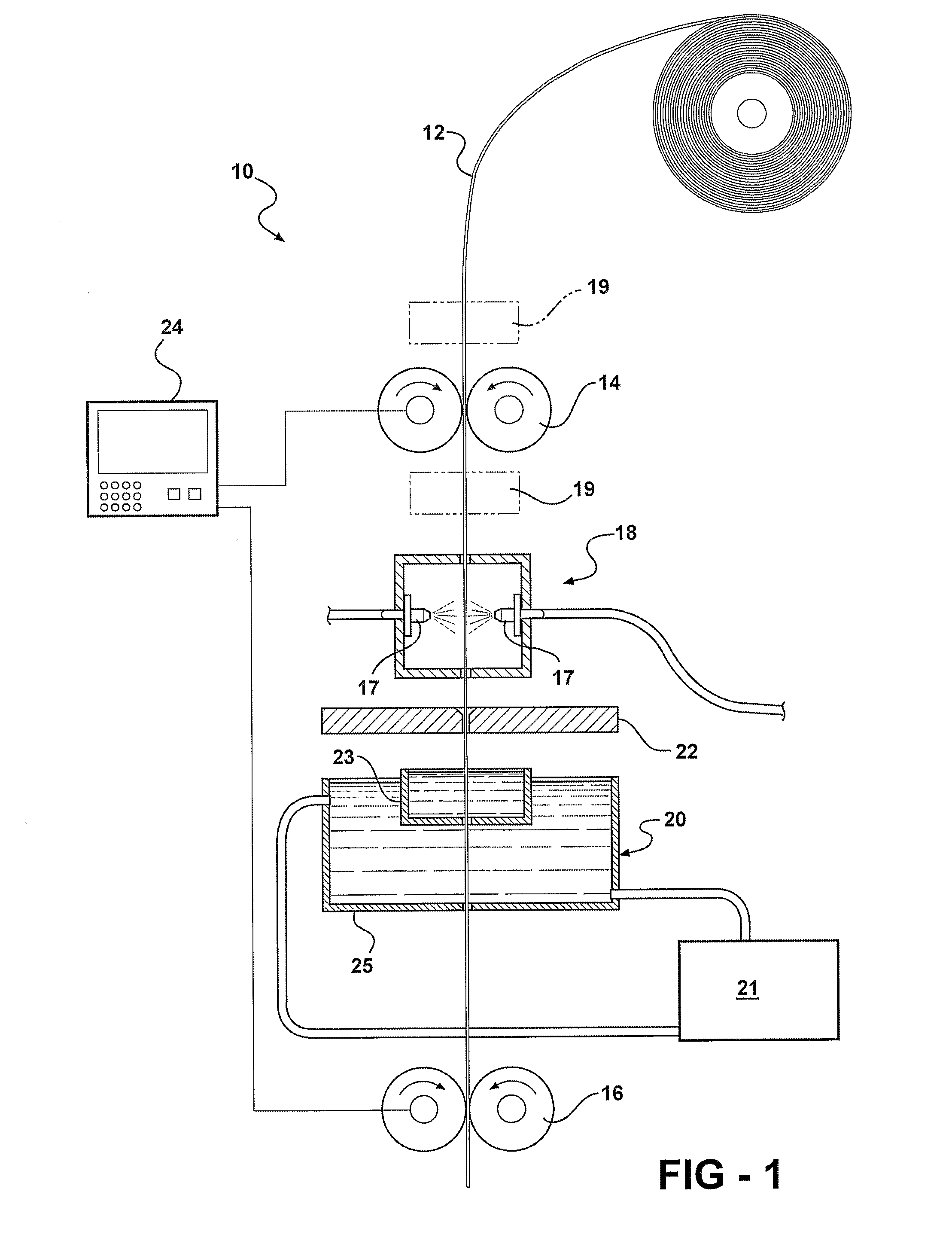Method and Apparatus for Micro-Treating Iron-Based Alloy, and the Material Resulting Therefrom
a technology of iron-based alloys and micro-treatment, which is applied in the field of treated iron-based alloys, can solve the problems of large equipment pieces for steel processing, high cost and dangerous heated fluids, and inability to produce desirable products, etc., and achieves the effects of reducing the need, reducing the quantity of bainite and/or martensite, and quick and inexpensive treatmen
- Summary
- Abstract
- Description
- Claims
- Application Information
AI Technical Summary
Benefits of technology
Problems solved by technology
Method used
Image
Examples
example 1
[0039] A strip of 1018-1020 low carbon steel of 0.064 inch thick by 3.02 inches wide was stretched under tension between two securement points in first and second tensioning units with a feed rate of 10.75 IPM (inches per minute) and a draw rate of 13.25 IPM. Between the securement points a primary heating unit blasted two sets of pinpoint high temperature flames, each about ½ inch in diameter towards the opposing faces of the steel strip to heat the steel to 1,900° F. As the steel moved and stretched downward through the first tensioning unit, a quenching unit bucket directed a cold water stream onto the heated steel strip under tension about ½ inch lower than the flame to cool the steel strip to about 57° F., yielding a steel that tested to be 30 Rc.
example 2
[0040] A strip of 8620 low carbon steel of 0.062 inch thick by about 3.00 inches wide was stretched between two securement points in a first and a second tensioning unit with a feed rate of about 10.75 IPM and a draw rate of about 13.25 IPM. Between the securement points a heating unit blasted two opposing sets of multiple pinpoint high temperature flames about ⅛ inch tall by 3 inches wide towards the opposing faces of the steel strip to heat the steel to about 2,350° F. As the steel moved and stretched downward through the first tensioning unit, a quenching unit directed a cold water stream onto the heated steel strip under tension about ¾ inch lower than the flames to cool the steel strip to about 70° F. within seconds, yielding a steel that tested to be 48 Rc. This material is found to have a micro-structural content that is 85 percent (85%) of bainite. The resulting thickness is controllably reduced from 0.062 inch to a range of 0.049 inch to 0.054 inch.
example 3
[0041] A strip of 1008 low carbon steel (about 0.036 percent carbon by weight) of 0.065 inch thick by 3.02 inches wide was stretched between two securement points in a first and a second tensioning units with a feed rate of about 10.75 IPM and a draw rate of from about 10.75 IPM to about 16 IPM. Between the securement points, a heating unit blasted two opposing sets of multiple pinpoint high temperature flames about ⅛ inch tall by about 3 inches wide towards the opposing faces of the steel strip to heat the steel to 2,250° F. As the steel moved and stretched downwards through the first tensioning unit, a quenching unit directed a cold water stream onto the heated steel strip under tension about ½ inch to 1 inch lower than the flame to cool the steel strip to about 70° F. within seconds, yielding a steel that tested to be from 1 to 36 Rc. This material is found to have a microstructure content that is mostly martensite. The resulting thickness is controllably reduced from 0.065 inch ...
PUM
| Property | Measurement | Unit |
|---|---|---|
| thickness | aaaaa | aaaaa |
| thickness | aaaaa | aaaaa |
| temperature | aaaaa | aaaaa |
Abstract
Description
Claims
Application Information
 Login to View More
Login to View More - R&D
- Intellectual Property
- Life Sciences
- Materials
- Tech Scout
- Unparalleled Data Quality
- Higher Quality Content
- 60% Fewer Hallucinations
Browse by: Latest US Patents, China's latest patents, Technical Efficacy Thesaurus, Application Domain, Technology Topic, Popular Technical Reports.
© 2025 PatSnap. All rights reserved.Legal|Privacy policy|Modern Slavery Act Transparency Statement|Sitemap|About US| Contact US: help@patsnap.com



